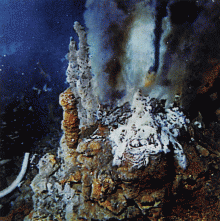September 16, 2010 report
Extremophile microbes survive only on energy from formate oxidation

(PhysOrg.com) -- A new study published in this week's issue of Nature reports the discovery of "extremophile" microbes living only on the energy produced by formate reactions in deep ocean vents.
Extremophiles are microbes that survive in the harshest environments on Earth, such as in acidic conditions, hot springs, inside glaciers, and in radioactive ponds.
The study, by Sung Gyun Kang and colleagues at the Korea Ocean Research and Development Institute in Ansan, reports on the single-celled organism, Thermococcus onnurineus, a member of the Domain Archaea. This archaeon lives in hot deep-sea vents, and is the first organism ever discovered surviving by itself only on the energy produced when formate (HCOO-) and water react to form bicarbonate and hydrogen.
This discovery follows a finding in 2008 of fermentive bacteria living off the formate reaction if cultured with methane-forming microbes that consume the hydrogen waste product. Removing the hydrogen was important because its accumulation inhibits the reaction. At the time the researchers proposed partnerships of this sort would be mutually beneficial in extreme anoxic environments.
The new finding was made during work on sequencing the genome of T. onnurineus. The researchers identified multiple copies of formate hydrogenases and dehydrogenases, which are believed to be required for anaerobic respiration reactions involving formate. To find out if T. onnurineus could live on the formate reaction without help, they grew it in suspension in the laboratory at 80ºC with no energy source present except formate. The experiments showed that when formate was added the culture grew and ATP (adenosine triphosphate, the energy currency of cells) was detected, but when no formate was added the culture failed to grow and no ATP was found. Other strains of Thermococcus were also found to grow on formate.
At 80ºC, Kang calculates the energy derived during the formate oxidation reaction yields 8-20 kJ per mole of formate. This is very little energy, but just enough to live on, and more than previously thought would be available. Kang said previous estimates were based on the reaction taking place at ambient temperatures. It is unclear how higher temperatures contribute to the higher energy production, and Kang said more study is needed.
The discovery of microbes that can continue to live on formate in the presence of hydrogen may provide more options for biohydrogen production, Kang said.
T. onnurineus lives in hot (up to 90ºC) hydrothermal vents off the coast of Papua New Guinea at depths of about 1,650 meters. Bacteria and archaea were probably the first organisms on Earth, and arose long before oxygen was available in the atmosphere.
More information: Formate-driven growth coupled with H2 production, Yun Jae Kim et al., Nature 467 , 352-355 (16 September 2010) doi:10.1038/nature09375
© 2010 PhysOrg.com

















